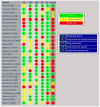A Systematic Review Exploring the Theories Underlying the Improvement of Balance and Reduction in Falls Following Dual-Task Training among Older Adults
- PMID: 36554771
- PMCID: PMC9778940
- DOI: 10.3390/ijerph192416890
A Systematic Review Exploring the Theories Underlying the Improvement of Balance and Reduction in Falls Following Dual-Task Training among Older Adults
Abstract
Background: Balance impairment causes frequent falls in older adults, and preventing falls remains challenging. Dual-task (DT) training reduces falls by improving balance, but the precise theory is not fully understood. This review aims to explore the theories underlying the effectiveness of DT in improving balance and reducing falls in older adults.
Methods: Eleven electronic databases were searched from database inception to June 2022. Two reviewers independently performed study screening and data extraction. The risk of bias (RoB) in the included studies was assessed using the Cochrane Collaboration RoB 2 tool.
Results: The searches yielded 1478 citations, of which 30 studies met the inclusion criteria and were included in the review. Twenty-two of the 30 included studies utilized the motor-cognitive type of DT for training, while six used motor-motor and two utilized cognitive-cognitive DT. The included studies reported 20 different theories to explain the effectiveness of DT for improving balance and reducing falls in older adults. The predominant theory identified in the included studies was attention theory (n = 14). Overall, 26 studies reported improved balance and five studies found a reduction in fall incidence following DT training. Balance and falls improved significantly in 15 motor-cognitive DT intervention studies.
Conclusion: Attention shifting between two tasks is reported to occur following DT training. Motor-cognitive DT training improves balance and reduces fall incidence in older adults by shifting attention based on the difficulty and priority of a task from the motor to the cognitive task.
Keywords: falls; motor cognitive interference; older adults; postural control.
Conflict of interest statement
The authors declare no conflict of interest.
Figures





Similar articles
-
Effectiveness of cognitive-motor dual task training in preventing falls in community older adults: A meta-analysis and systematic review.Geriatr Nurs. 2025 Jul-Aug;64:103366. doi: 10.1016/j.gerinurse.2025.05.005. Epub 2025 May 26. Geriatr Nurs. 2025. PMID: 40410069
-
Dual task training effects on gait and balance outcomes in multiple sclerosis: A systematic review.Mult Scler Relat Disord. 2021 Apr;49:102794. doi: 10.1016/j.msard.2021.102794. Epub 2021 Jan 27. Mult Scler Relat Disord. 2021. PMID: 33540278
-
Comparison between the effects of exergame intervention and traditional physical training on improving balance and fall prevention in healthy older adults: a systematic review and meta-analysis.J Neuroeng Rehabil. 2021 Nov 24;18(1):164. doi: 10.1186/s12984-021-00917-0. J Neuroeng Rehabil. 2021. PMID: 34819097 Free PMC article.
-
Motor Cognitive Dual-Task Testing to Predict Future Falls in Multiple Sclerosis: A Systematic Review.Neurorehabil Neural Repair. 2022 Dec;36(12):757-769. doi: 10.1177/15459683221131791. Epub 2022 Nov 1. Neurorehabil Neural Repair. 2022. PMID: 36320121
-
Technology-Assisted Motor-Cognitive Training Among Older Adults: Rapid Systematic Review of Randomized Controlled Trials.JMIR Serious Games. 2025 Jun 3;13:e67250. doi: 10.2196/67250. JMIR Serious Games. 2025. PMID: 40460432 Free PMC article. Review.
Cited by
-
Comparative effects of cognitive and instability resistance training versus instability resistance training on balance and cognition in elderly women.Sci Rep. 2024 Oct 30;14(1):26045. doi: 10.1038/s41598-024-77536-x. Sci Rep. 2024. PMID: 39472492 Free PMC article. Clinical Trial.
-
Standing Postural Balance Control in Women with and Without Urinary Incontinence: A Systematic Review.Int Urogynecol J. 2025 Apr 30. doi: 10.1007/s00192-025-06109-x. Online ahead of print. Int Urogynecol J. 2025. PMID: 40304785 Review.
-
Key accelerometry measures for understanding walking sway during dual-task exercises.Heliyon. 2025 Jan 24;11(4):e42160. doi: 10.1016/j.heliyon.2025.e42160. eCollection 2025 Feb 28. Heliyon. 2025. PMID: 40028607 Free PMC article.
-
Effectiveness and cost of integrated cognitive and balance training for balance and falls in cerebellar ataxia: a blinded two-arm parallel group RCT.Front Neurol. 2024 Jan 19;14:1267099. doi: 10.3389/fneur.2023.1267099. eCollection 2023. Front Neurol. 2024. PMID: 38313407 Free PMC article.
-
Self-administered dual-task training reduces balance deficits and falls among community-dwelling older adults: a multicentre parallel-group randomised controlled trial with economic evaluation protocol.BMJ Open. 2025 Jun 24;15(6):e089915. doi: 10.1136/bmjopen-2024-089915. BMJ Open. 2025. PMID: 40555445 Free PMC article.
References
-
- World Health Organization (WHO) Falls. [(accessed on 18 April 2022)]. Available online: https://www.who.int/news-room/fact-sheets/detail/falls.
-
- Kyu H.H., Abate D., Abate K.H., Abay S.M., Abbafati C., Abbasi N., Abbastabar H., Abd-Allah F., Abdela J., Abdelalim A., et al. Global, regional, and national disability-adjusted life-years (DALYs) for 359 diseases and injuries and healthy life expectancy (HALE) for 195 countries and territories, 1990–2017: A systematic analysis for the Global Burden of Disease Study 2017. Lancet. 2018;392:1859–1922. doi: 10.1016/S0140-6736(18)32335-3. - DOI - PMC - PubMed
-
- Haagsma J.A., Graetz N., Bolliger I., Naghavi M., Higashi H., Mullany E.C., Abera S.F., Abraham J.P., Adofo K., Alsharif U., et al. The global burden of injury: Incidence, mortality, disability-adjusted life years and time trends from the Global Burden of Disease study 2013. Inj. Prev. 2016;22:3–18. doi: 10.1136/injuryprev-2015-041616. - DOI - PMC - PubMed
-
- James S.L., Lucchesi L.R., Bisignano C., Castle C.D., Dingels Z.V., Fox J.T., Hamilton E.B., Henry N.J., Krohn K.J., Liu Z., et al. The global burden of falls: Global, regional and national estimates of morbidity and mortality from the Global Burden of Disease Study 2017. Inj. Prev. 2020;26:i3–i11. doi: 10.1136/injuryprev-2019-043286. - DOI - PMC - PubMed
Publication types
MeSH terms
LinkOut - more resources
Full Text Sources
Miscellaneous

